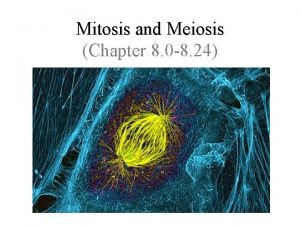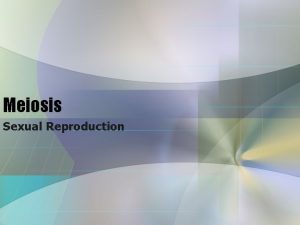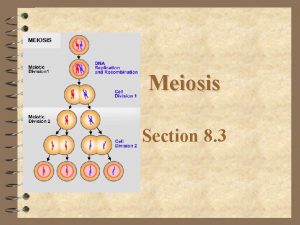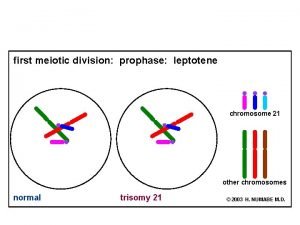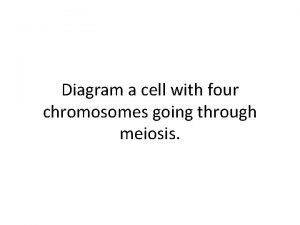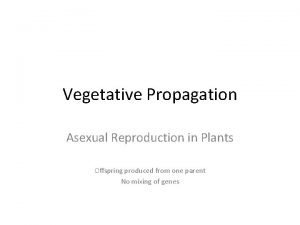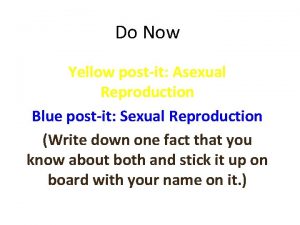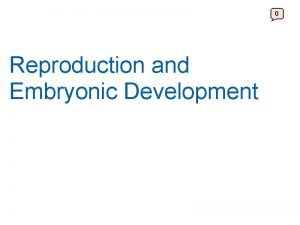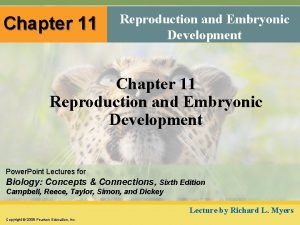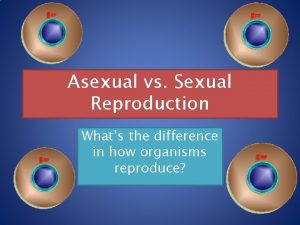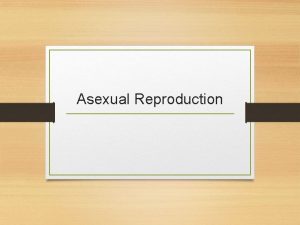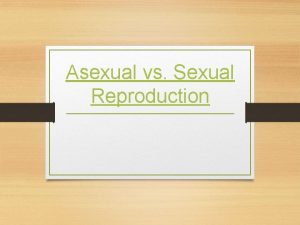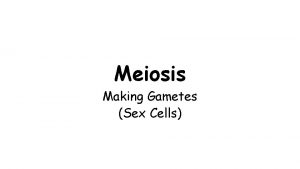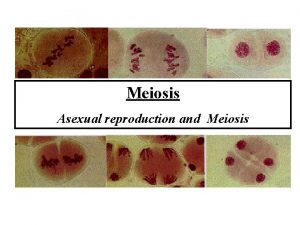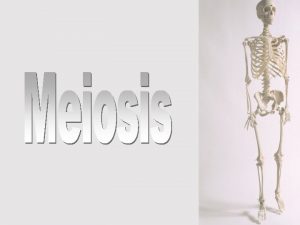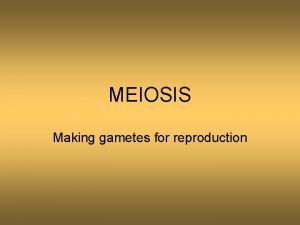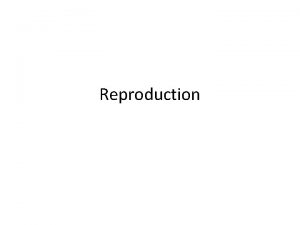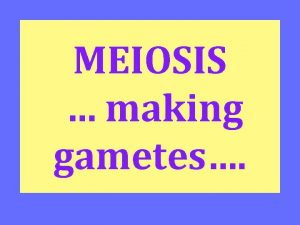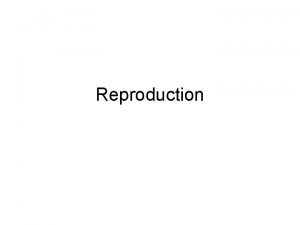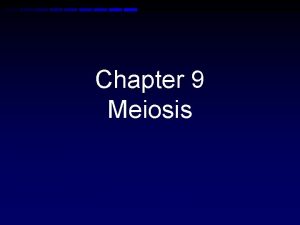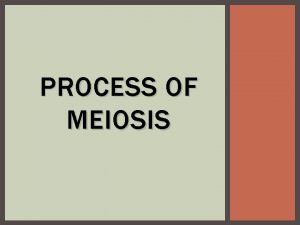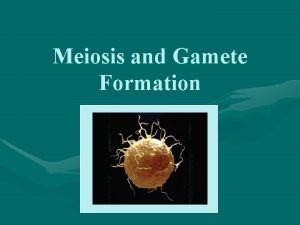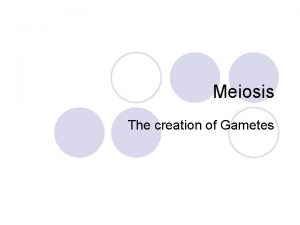Meiosis Making Gametes Review Asexual Reproduction is also





















- Slides: 21

Meiosis Making Gametes

Review • Asexual Reproduction is also called ________ • Mitosis starts with one parent cell and ends up with _____________________ • Genetically, the daughter cells are ________ to the parent cell • Making an identical copy of a cell is also called ________ • What type of cells in YOUR BODY divide by Mitosis? ________ • The scientific term for Body cells is _______ • These cells are considered 2 n (diploid). What does that mean? ____________________

Review Cont’d • How many Chromosomes should a normal human have? _____ • If a human skin cell must divide to heal a wound, how many chromosomes would each of the daughter cells have? _____ • If a human bone cell must divide because a baby is growing, how many chromosomes would each of the daughter cells have? _____ • What are two reasons for Mitosis? _____ & ______ • Which organelle is in control of cell division? ______ • What happens when the nucleus loses control? _____

Mitosis • Asexual Cell Reproduction • Necessary for growth & repair • Chromosomes in Somatic Cells are in pairs • 2 N (diploid) • Two new daughter cells are identical copies of original parent cell • Clones


Cell Cycle • Sequence of phases in the life cycle of the cell Notice! Mitosis is only a SMALL part of the cell cycle! In what phase do cells spend most of their time? _______ Mitosis & Cell Cyle

Sex Cells are Different • Human beings have 46 chromosomes in every Somatic (Body) Cell • This is a complete set • But, if mom’s egg cell has 46… • And, if dad’s sperm cell has 46… • The Zygote (the fertilized egg cell) would have 92! • Would THAT make a human?

Meiosis • Cell division of reproductive cells (sex cells) • Gametes or germ cells (sperm and egg) • Produced in Gonads • Each new cell is not exactly like the parent cell • Allows for variation • Important for the survival of our species!

Meiosis • In each new daughter cell, the chromosomes are not in pairs • NOT 2 n (not diploid!) • At the end of Meiosis, four daughter cells contain half of the original number of chromosomes (N) • Each is unique! • Not identical to the parent

Gametes (aka germ cell) • Mature egg or sperm cell • Produced in the Gonads • Each gamete has half the original number of chromosomes • 1 N (haploid) • HALF IS IMPORTANT!

Why is Half is Important? • Meiosis makes unique sex cells! • Half the number of chromosomes (haploid) is important for sexually reproducing organisms! • N = The number of chromosomes in a gamete • To create a new organism, two parents give half of their own chromosomes to make a baby with a complete set of chromosomes! • Half from mom • Half from dad • N + N = 2 N (Zygote!)

Sexual Reproduction • Sexual Reproduction requires two parents • Offspring have SOME traits inherited from each parent… but not all! • YOUR DNA is not identical to either parent • It is a mix of genes from both parents Meiosis

Sexual Reproduction • Fusion of two (N) gametes to produce a single zygote (2 N) • Introduces greater genetic variation, allows genetic recombination • A VERY GOOD THING!

Chromosome Pairing • Homologous pair • Homologous means similar • Each chromosome in the pair are Homologous to the other (carry genes for same trait) • Only one pair differs - sex chromosomes X or Y

Different! Metaphase I in Meiosis… Chromosomes form TETRADS (four together) Metaphase II in Meiosis… Chromosomes line up in the middle and then a SECOND DIVISION happens! The two daughter cells are divided into four and each has HALF the chromosome number!

Independent assortment of homologous chromosomes POSSIBILITY 1 POSSIBILITY 2 Two equally probable arrangements of chromosomes at metaphase I Metaphase II Gametes Combination 1 Figure 8. 16 Combination 2 Combination 3 Combination 4

Crossing over increases genetic variability • The exchange of genes between two homologous chromosomes happens when in Tetrad formation

Tetrad Chaisma Centromere Figure 8. 18 A

SPERMATOGENESIS OOGENESIS spermatogonium oogonium egg spermatids polar bodies (will disintegrate)


Review Mitosis & Meiosis • Both are forms of cell division • Both involve replication • Both involve disappearance of the nucleus, and nucleolus, nuclear membrane • Both involve formation of spindle fibers
 Sexual and asexual reproduction venn diagram
Sexual and asexual reproduction venn diagram Hare lynx
Hare lynx Venn diagram asexual vs sexual reproduction
Venn diagram asexual vs sexual reproduction Meisosis
Meisosis Meiosis makes gametes
Meiosis makes gametes Meiosis makes gametes
Meiosis makes gametes Meiosis diagram
Meiosis diagram Diagram a cell with 4 chromosomes going through meiosis
Diagram a cell with 4 chromosomes going through meiosis Dahlia asexual reproduction
Dahlia asexual reproduction Examples of asexual reproduction
Examples of asexual reproduction Segmentation of platyhelminthes
Segmentation of platyhelminthes Parthenogenesis
Parthenogenesis Examples of asexual propagation
Examples of asexual propagation Layering asexual reproduction
Layering asexual reproduction Asexual
Asexual Asexual reproduction
Asexual reproduction Gastrula
Gastrula Asexual reproduction cell division
Asexual reproduction cell division Whats asexual reproduction
Whats asexual reproduction Sexual example
Sexual example Chapter 19 asexual reproduction
Chapter 19 asexual reproduction Mitosis and meiosis
Mitosis and meiosis



